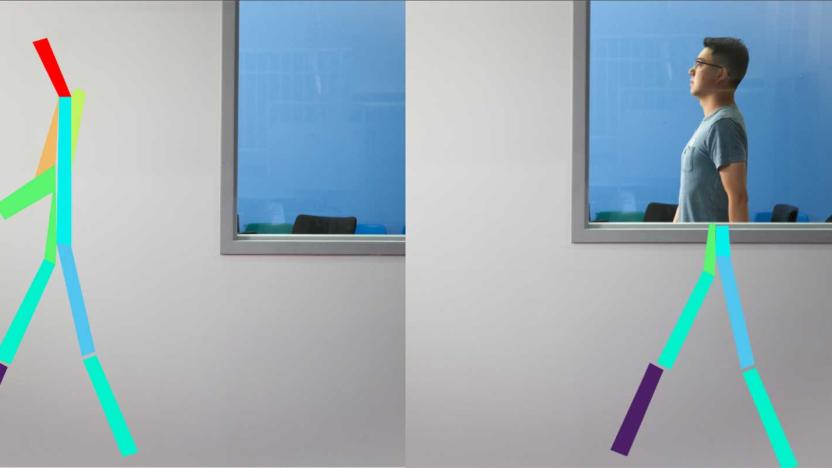RadioFrequency
Latest

AI detects movement through walls using wireless signals
You don't need exotic radar, infrared or elaborate mesh networks to spot people through walls -- all you need are some easily detectable wireless signals and a dash of AI. Researchers at MIT CSAIL have developed a system (RF-Pose) that uses a neural network to teach RF-equipped devices to sense people's movement and postures behind obstacles. The team trained their AI to recognize human motion in RF by showing it examples of both on-camera movement and signals reflected from people's bodies, helping it understand how the reflections correlate to a given posture. From there, the AI could use wireless alone to estimate someone's movements and represent them using stick figures.

How RFID tags became trendy
As far as wireless technologies go, radio-frequency identification (RFID) is one of the oldest. Patented in 1983 by the late British inventor Charles Walton, RFID made it possible for new, cutting-edge tech such as near-field communication (NFC) to exist. As with NFC, RFID chips are used to store information digitally, which can then be shared between objects through electromagnetic fields and radio waves. It may not be sexy, but companies see real potential in the technology, no matter how old. It's no surprise, then, that over the past few years RFIDs have become ubiquitous in a wide range of industries, including travel, sports and one you wouldn't expect: fashion.

Disney's smart toys combine Avengers, sensors and imagination
Those giant, green Hulk hands in your closet might be cool but their utility doesn't extend much beyond freaking out your cat and making tired "you wouldn't like me when I'm angry" jokes. Disney has an idea to remedy that with internet-connected versions of those as well as a pair of Iron Man gauntlets. Wait, smart toys? Yep. As The Wall Street Journal tells it, these Playmation devices will work in concert, via radio frequency and infrared signals, with special action figures as well as other branded apparatus you strap on to your body. Based on what TechCrunch says, these sound an awful lot like a home laser-tag set. Different playthings offer different augmentations (action figures come with new, narrated, playable stories, and you can buy more of the latter via a connected app) but they won't all work together.

World's smallest FM transmitter built with graphene, ruined by Psy
Researchers have been using graphene to develop an assortment of technologically advanced things for a while, from camera sensors and contact lenses all the way to frickin' lasers. That's why it's not a surprise to see a group of engineers from Columbia University create the world's smallest FM transmitter using the atom-thick material. The end product isn't just for show, either, as it can pump tunes over the airwaves to a regular FM radio -- the team even used Gangnam Style to prove that it works. As interesting as the teensy transmitter is, the engineers have no plans to build a radio for ants, and this is merely part of a larger study into nano-electromechanical systems. Now all we need is for someone to make a tiny violin and a pair of tweezers small enough for us to play.

Phi: a wireless re-routing card that puts you in control of the airwaves (video)
For all the talk of convergence in mobile devices, there's relatively little chatter about the coming together of wireless signals themselves. In other words, why should we have a separate device to interact with each type of wireless signal? And so, with that intriguing question, begins the pitch for a new device call Phi. It's a $750 antennae-laden PCIe card that slots into a desktop and gathers up wireless signals that are flying around the home -- so long as they have a frequency below 4GHz and don't involve bank-busting neutrinos. The card then allows custom apps to re-direct those transmissions as you like: potentially acting as a "base station" so you can make free calls from your cell phone, or receiving over-the-air HD transmissions which you can play on your tablet, or doing whatever else hobbyists and devs can cook up. Phi is still version 0.1 and Linux-only while the startup behind it -- Per Vices -- looks for a Kinect-style blossoming of third-party interest, but with nothing less than a deity-like command over the domestic ether on offer, how could it ever fail?

Uncle Sam's nefarious plot to pwn your garage door
Republican / Democrat, Christian / Muslim, Team Kristin / Team LC -- despite our many differences, if there's one issue that all Americans can agree on, it's that law-abiding, tax-paying citizens should have unalienable sovereignty over their automatic garage doors. So you can imagine the uproar occurring right now in Colorado Springs, Colorado, ever since the nearby Cheyenne Mountain Air Station (headquarters of the North American Aerospace Defense Command) began testing an emergency radio frequency that has the unintended consequence of pwning numerous garage doors within a 10-mile radius. It would be one thing if the doors just randomly opened and closed on occasion -- smashing a few windshields and delivering a few good laughs -- but apparently the Air Force signal completely flummoxes the garages' RF receivers, often resulting in a pricey house call or an even pricier replacement unit. According to David McGuire, owner of the suddenly-profitable Overhead Door Co, it may be possible to slightly tweak the transmission frequency and put an end to this madness -- an option that Captain Tracy Giles and team are reportedly looking into. While it may be somewhat of an overstatement to call this the most pressing issue that the country has ever faced, if we don't come together as a nation and nip this outrage in the bud, what's stopping Big Brother from waltzing in and breaking our home surveillance cams, car door locks, or -- gasp -- even our remote-controlled projection screens.[Via The Inquirer]




